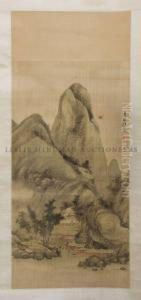Cheng Zhengkui Paintings
Cheng Zhengkui, also known as Cheng Sui, was a Chinese landscape painter during the Ming Dynasty and early Qing Dynasty, born in 1604 in Changzhou, Jiangsu province. He belonged to a family of scholars and officials, which gave him access to a good education and literacy in classical Chinese culture. This background deeply influenced his artistic work, which is often characterized by a combination of painting, poetry, and calligraphy, a tradition known as the 'Three Perfections' in Chinese art.
Cheng Zhengkui is particularly known for his detailed and delicate brushwork in ink and light colors on paper. His landscapes often depict the serene beauty of nature, featuring mountains, rivers, trees, and sometimes small figures within these settings. He followed the style of the Yuan Dynasty artists, especially Wang Meng, whose influence is evident in Cheng's use of dense and intricate brushstrokes to build up the texture and form of rocks and trees.
Despite living during a tumultuous period in Chinese history marked by the fall of the Ming Dynasty and the rise of the Qing Dynasty, Cheng Zhengkui managed to maintain a successful career. He passed the imperial examinations and held various official positions, though it is his contribution to Chinese painting for which he is most remembered.
His works were widely admired for their scholarly qualities and adherence to the classical styles of earlier masters. They often conveyed a sense of tranquility and withdrawal from the political upheaval of his times, which resonated with the literati class who sought refuge in the arts from the chaos of the outside world.
Cheng Zhengkui's paintings can be found in various museum collections and have been studied extensively for their historical and artistic significance. Despite the changing dynasties, he maintained a steadfast commitment to the literati ideals of his time, making him an important figure in the history of Chinese painting. He passed away in 1670, leaving behind a legacy that would influence future generations of Chinese artists.

